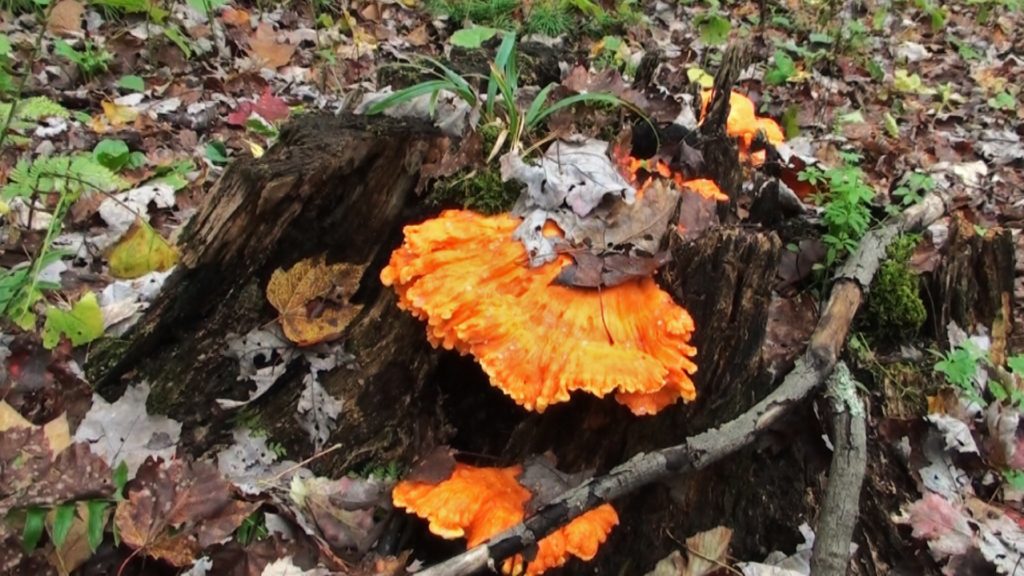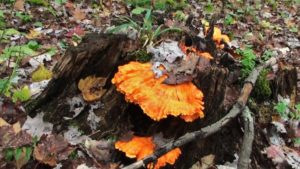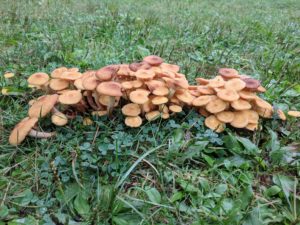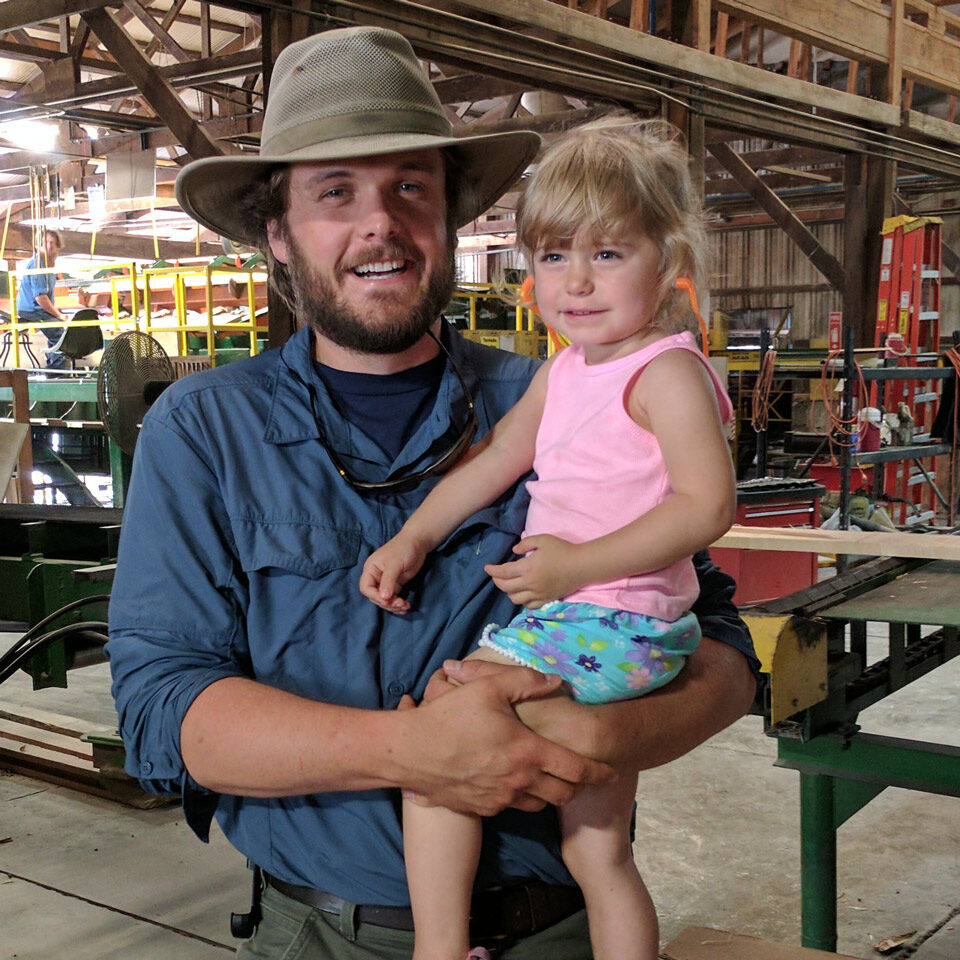
Fall Mushroom Hunting in Pennsylvania | John Royer, Leatherwood Outdoors
The vibrant colors of fall are a clarion call of sorts to the cool, crisp mornings and many outdoor adventures. As this time of year approaches, many outdoorsman look forward to sitting in their archery stand with hopes of encountering a Booner and watching all the wildlife prepping for winter. But, there is something else that captures the interests of hunter enthusiasts while not in the deer stand and allows them to still put food on the table—fall mushroom hunting. Mushroom hunting is common in the spring yet can be lost amongst the more charismatic pursuits in the fall. When the rainy days come in the fall and you’re not sure how to enjoy the outdoors, jump in your car and take a drive and look at the colorful leaves and look for mushrooms. Mushroom hunting in the fall provides a way to enjoy the colorful leaves while looking for specific tree species. Mushroom aficionados know that hunting is a year-long pursuit and each outing is a curious hunting ground. It never ends!
The Initial Steps for Mushroom Hunting
Fungi are excellent and efficient wood destroyers.[1] Therefore, the logical and initial step in mushroom hunting the four prized fall mushrooms is learning the skill of tree identification. An easy place to start is learning to identify oak species, especially white oak. With a firm grasp of the shape and color of its bark and the leaf shape and color (especially their fall colors), jump in the car or take a walk through the woods. Now, finding and remembering the location of the correct trees can be a hunt in itself, so always keep a note of where you find these trees (for future hunting pleasure). You may want to come back to them later next year as different mushrooms come out at different times of the year. Prior to our discussion, it is important to mention that if you would happen to spot any mushroom(s) on the roadside or near a parking lot, it is recommended not to pick them. The reason is that many pollutants and herbicides are used along roadways and public places. Therefore, it is best to hunt for mushrooms well away from the road. It is wise to use caution.
Hunting for a Chickens in the Woods

The first mushroom of interest is Chicken of the Woods. Another name for it is Sulfur Shelf because of the shelf-like growing structure on the side of trees or stumps. Furthermore, this mushroom literally tastes like chicken, hence the name Chicken of the Woods. Chicken of the Woods is a good starting point for beginning hunters because is very easy to find (throughout the spring, summer, and fall) and it does not have poisonous lookalikes. There are two kinds of Chicken of the Woods and both are valued edible mushrooms, but I will be focusing on Laetiporus sulphureus which is most commonly found in the fall. Three main characteristics of this mushroom are: 1) It grows on a stumps or fallen tree limb. You will not find this mushroom growing on the ground, 2) It is bright blaze orange on top couple with a bright sulfur yellow colored underside, and 3) It does not have gills or a stem. I found my first one ever as I was looking out the window (of my car) while my wife was driving down a backroad in mid-September. I caught a glimpse of a bright orange mushroom on an oak stump 20 yards off the road. I had her stop and turn around. I ran out of the car and there it was, my first chicken! I harvested the mushrooms and safely tucked it in a plastic bag so that we could devour them at home. The best way to harvest this mushroom is to cut the outer ring of the mushroom where it is most soft and flexible which is usually the first 1–2 inches. We cleaned and fried it up with some butter, salt and pepper. It was delicious! A simple way to prepare this mushroom for consumption is to cut it in bite sized pieces and put it in a skillet with some butter. Salt and pepper to taste and cook until it turns golden brown on the edges. My wife loved it so much that now all she does is look for mushrooms everywhere we go!
Hunting for Sheep, Rams, and Hens in the Woods
 The second fall mushroom is the Sheepshead Mushroom (Grifola Frondosa), also known as Maitake, Rams Head, and Hen of the Woods. Like with the Chicken of the Woods, I found my first one by spotting it right next to the road while looking out the window as my wife was driving. This mushroom also loves white oak trees and you will typically find them growing on the ground close to dead and dying oak trees or stumps. In some cases, this mushroom is very hard to spot; therefore, it will be more difficult to see from a moving vehicle. This mushroom is grey, light tan, or brown on the top. They sprout out feather like florets and can grow very quickly and get very big. It is pure white underneath with no gills. It might look like a pile of dead leaves to some people, but do not be fooled! Sheepshead is highly sought after not only because it is a delicious edible mushroom, but also because it has medicinal qualities. Also, it is it high in vitamins, minerals, and antioxidants while it supposedly has cancer fighting properties along with numerous other health benefits.
The second fall mushroom is the Sheepshead Mushroom (Grifola Frondosa), also known as Maitake, Rams Head, and Hen of the Woods. Like with the Chicken of the Woods, I found my first one by spotting it right next to the road while looking out the window as my wife was driving. This mushroom also loves white oak trees and you will typically find them growing on the ground close to dead and dying oak trees or stumps. In some cases, this mushroom is very hard to spot; therefore, it will be more difficult to see from a moving vehicle. This mushroom is grey, light tan, or brown on the top. They sprout out feather like florets and can grow very quickly and get very big. It is pure white underneath with no gills. It might look like a pile of dead leaves to some people, but do not be fooled! Sheepshead is highly sought after not only because it is a delicious edible mushroom, but also because it has medicinal qualities. Also, it is it high in vitamins, minerals, and antioxidants while it supposedly has cancer fighting properties along with numerous other health benefits.
Hunting for Honey in the Woods
The third mushroom is the Honey Mushroom (Armillaria mellea). This will grow in patches or clusters on the ground or on trees and stumps of dead and dying oak trees. There are two main kinds of honey mushrooms. One has a ring around the stem and the other does not. Both have yellow to light brown color or a honey color on the top and white gills underneath. Both are edible, but you should always make positive identification because there is a poisonous lookalike. This brings me to a tip that an experienced mushroom hunter once told me. Mushroom hunter pro-tip #1: make sure you use at least three mushroom identification books. Try to find books that focus mainly on the region you plan to hunt for mushrooms. Never positively confirm the identification of mushroom solely based on pictures because images can look very different in various publications. The more books you have the easier it will be to identify a variety of mushroom species.
Hunting for a Lions in the Woods
The last mushroom I would like to talk about is the Lion’s Mane (Hericium erinaceus). Another name for this mushroom is called Bearded Tooth Mushroom. This mushroom is harder to find than the others listed above. Although I have not hunted for it specifically, I have never run into it while hunting. This mushroom has eluded me for years! Lion’s Mane grows on hardwoods (including American beech). It is supposed to have a taste like seafood or lobster taste. It also has many health benefits as well. Sometimes this mushroom can be hard to see because it can grow very high up on dead and dying trees. If you do spot one to harvest, you must be very careful harvesting it. This mushroom is unlike all the others. It looks like a white spiny ball that is stuck to the side of the tree. It has many little spines that hang from it in all directions.
Happy Fall Mushroom Hunting!
An intriguing aspect of mushroom hunting is that there is always a challenge. There are some that are easy to find and to identify and some are not while some are edible and others are poisonous. There is so much information about mushrooms and the role they play in the forests and landscape that there is always something new to learn and something to hunt for in the woods. Whether it be tree identification or the search for a wild edible mushroom there is always a reason to explore the outdoors no matter the weather conditions or time of year. [1] George Barron, Mushrooms of Northeast North America: Midwest to New England (Edmonton: Partners Publishing and Lone Pine Media Productions, Ltd., 2014), 27.
Resource Recommendations
Field Guide to Wild Mushrooms of Pennsylvania and the Mid-Atlantic by Bill Russell
Mushrooms of West Virginia and the Central Appalachians By William C. Roody
Trees of Pennsylvania Field Guide by Stan Tekiela
See Legacy Land & Wildlife website for additional resources

About Dave Duell
Outdoorsman, conservationist, forester, father, husband, and Christian: Dave Duell owns and manages Legacy Land and Wildlife LLC and provides conservation and forestry services and guidance to Pennsylvania and Ohio. It's his passion to assist and educate land owners and other outdoors enthusiasts about the importance of being a good steward of their land and the wildlife therein. Learn more about Dave and Legacy Land & Wildlife by clicking here.
12 Comments
Leave a Comment

Legacy Land & Wildlife LLC is your resource for forestry, conservation, and land & wildlife stewardship. Based in Eastern Ohio, we provide services to Ohio, Pennsylvania, and beyond.

This would make a great feature story for the Leader-Vindicator and the Tri-County Sunday.
I’m Susan Kerr, a columnist and freelance writer for both papers. I live in South Bethlehem over here in Armstrong County, and my dad used to take us out in the woods all the time when we were little kids. I would bet that any number of our readers could relate to this story.
May I come out and interview you for an article sometime in October?
Hi, Susan!
I am glad you enjoyed the article! It was a fun collaboration with John and I.
John and his wife love hunting for mushrooms! As a consulting forester/land and wildlife steward, I learned about fungi and mushrooms in school and I see them all of the time on the properties I manage.
We will be in touch with you regarding your question.
Thank you for reaching out!
Hello John Royer, I live near Cumberland Md.on Cash Valley Road. I was on a dirt road on our farm when I came across a mushroom that I never saw before. It was very large and between a yellow and a red. It was very big and at the same time I came across a puffball that was white and it looked like a porcupine only all white and as big as a small foot ball. Can you help me. I spent a lot of my life hunting morels in the spring. I am 79 years old an can’t do a lot of woods walking but I still love it. Let me know, Glenn Stahlman 301-724-0164.
Hi, Glen! Thank you for touching base on this blog! I will forward your message on to John.
Hi Glenn. I am not sure what the large yellow and red mushroom could be. There could be a number of different ones that could fit that description. As for the spiky looking puffball. I have seen them before but I do not know much about them. Morels are my favorite mushroom to eat. We have some videos on our youtube channel called leatherwood outdoors. if you get on there and look around for some mushroom videos we might be able to help you out with some things.
Oh man it sounds like u found a lion’s mane mushroom 11 years an still only ever got 1 here in Pennsylvania Sir.
I just found 2 huge ones from last season rotting while in the woods looking for moraels yesterday I hear there pereneal so I’m excited to go back this fall and check I’m in nw pa halfway between Pittsburgh and Erie basically…good luck
Great article and very informative. Do you have any recommendations on books or literature for mushrooms and tree identification? I live east of Pittsburgh, towards the Greensburg area and would like to find a club or group involved in this so I can get started.
Thank you for your comment, Steve! I have some good tree ID resources on my website (https://legacylandandwildlife.com/resources/). I will have John give some feedback as well.
Greetings new to shroom hunting, wet very old growth hard woods, so far this fall I am confused. Yes a chicken of woods, beautiful, on ground Lyons mane in many small clumps, still not sure white lacy smells fragrant, on return saw 1 small purple slippery cap, unsure, also came upon a rough surface BLACK 3” shroom. Excited that I’m comfortable enough with c of woods That I can trim two inches outside edge to sauté and season, the too many to count on my walk are foreign to me a novice hunter gatherer. Be well stay safe, there’s no covid virus in the wilderness, Clyde
Hi, Clyde! Thank you for reading and leaving a comment! Keep up the mushroom hunting! Take care!
Appreciate you brother man, not just for your knowledge but helping folks be aware. Rusty